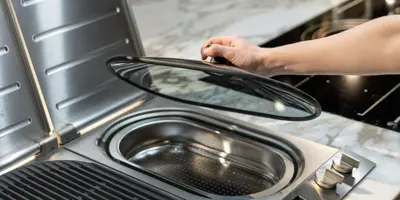2 people found this helpful

Kitchen safety rules may not sound nearly as glamorous as the exciting creations that you make in your kitchen, but they are not something we should ignore either! The kitchen is a place of adventure, fun and imagination, but that doesn’t mean it comes without its hazards. Understanding the basic kitchen dangers can help you achieve your culinary goals, while also minimising your risk or the risk of your loved one’s safety when in the kitchen.
Heat and blades need to be handled the proper way to avoid cuts, burns or other potentially serious accidents. Let’s take a look at some of the kitchen rule basics, so you can enjoy spending a fun but also safe time in the kitchen.
Your basic kitchen safety rules
Wear appropriate clothing
Possible hot splatters or sharp falling objects in the kitchen mean that you should try and wear clothing that covers your arms and feet when in the kitchen. Loosely hanging clothing can also pose a risk of falling down into food or even catching alight, so be sure to either role up the cuffs of your sleeves or change into something more suitable before you start cooking.
Use knives the right way
They can be sharp and ruthless, and are probably considered one of the more dangerous tools in the kitchen; so knowing how to use a knife properly is an absolute essential in kitchen safety rules. When using a knife, the main instructions to consider are:
- Always cut away from yourself or in a downwards motion
- Only pick up a knife by its handle
- Do not try and catch a falling knife – let it fall to the ground and then pick it up
- Make sure to properly store your knife away after using it
- Carry your knife with the blade tip facing down
- Remember to keep your knives sharpened – more accidents happen when you have to exert more force using a blunt blade
Handle hot dishes properly
You can’t smell or see heat, so make sure to always be safe when handling hot dishes or utensils to prevent any nasty burns. Always have potholders and oven mitts on hand for when handling any potentially hot items; remembering that tea towels don’t adequately protect you from heat!
Learn about fire hazards
Handling a fire may seem like an unnecessary skill to learn, but cooking experiments can sometimes take a turn for the worse and in those situations it’s better to be over-prepared than not. Here are some useful fire safety tips:
- Don’t leave pans unattended when cooking
- Remember to turn off all appliances once you have finished cooking
- Always put a lid on stovetop fires
- Keep loose clothing, fabrics and tea towels away from the stove
- Never use water to extinguish a fat or oil fire
- Put a fire out using an extinguisher or fire blanket if you have one
- In the event of an uncontrollable fire; leave the kitchen, close the door and call the fire brigade immediately
Wash your hands regularly
Before, after and during cooking you should be washing your hands regularly to prevent the risk of cross-contamination and the spread of nasty bacteria. Remember to also dry your hands after washing them as wet hands spread germs more easily than dry hands do – you can keep some Plenty towels around the kitchen to help with this!
Your basic kitchen safety rules for kids
Teaching your kids to cook from an early age is a great activity and also makes for great fun too –provided that all the proper safety measures are in place! To avoid any accidents, here are some top tips for teaching your little ones some basic kitchen safety rules:
- Create “off-limit” areas and “adult only” utensils
- Always supervise kids while they are in the kitchen
- Even though it can taste delicious, try to avoid letting kids eat raw batter!
- Do not let kids run around the kitchen
- Make sure any appliances are turned off and that loose cords are safely stored away
Tip
Turn the handles of saucepans and pots away from the front of the stove so that they are not sticking out. This should ensure that no one accidentally knocks over or spills any hot contents onto themselves when walking past the stove.
Check out our page on specific kitchen hygiene rules for further information.
These basic kitchen safety rules should help you prevent accidents while also enjoying all the fun and messiness of cooking with the whole family. If you want to learn more about family friendly kitchen tips, why not check out our articles on the 10 rules of basic hygiene for kids who love cooking and clever kitchen tips.
Related articles
How to wash fruit and vegetables at home
If you’d like to learn how to clean fruits and vegetables properly this is the article for you. Follow our step-by-step guide to washing fruit & veg here.

How to clean baking trays until they shine
Wish your dull, dirty baking tray could sparkle like new? Learn the best way to clean baking trays with just a little elbow grease in 7 easy steps.
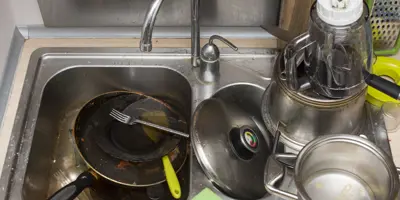
10 rules of basic hygiene (for kids who love to cook)
It’s never too early to teach budding chefs about basic food hygiene and how to prepare food safely. Read on for 10 essential food hygiene rules.
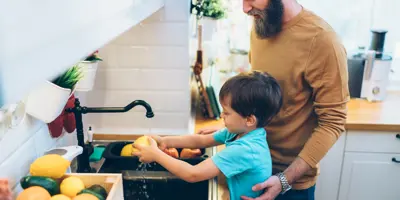
Learn how to clean the microwave with 3 easy methods
Discover the best ways to clean the microwave, including how to clean a microwave with lemon, vinegar, and how to get a clean microwave with baking soda.
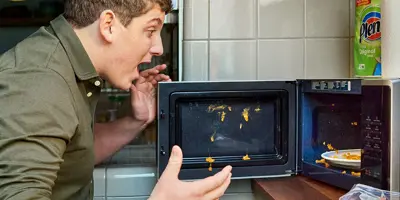
The 10 golden rules of kitchen hygiene
Find out how to keep on top of kitchen hygiene and reduce the risks posed by bacteria by learning these simple kitchen hygiene rules.
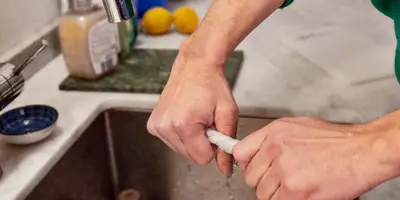
How to clean a deep fat fryer: 10 easy tips
Learn how to clean a deep fat fryer swiftly and safely! These 10 tips show you the best way to clean deep fat fryer interiors and exteriors.
